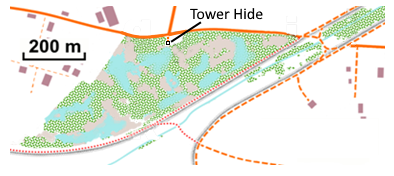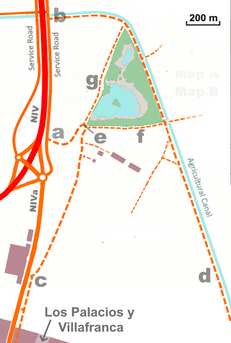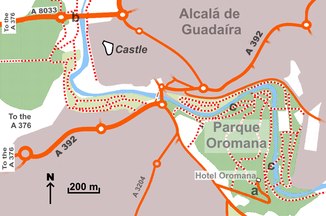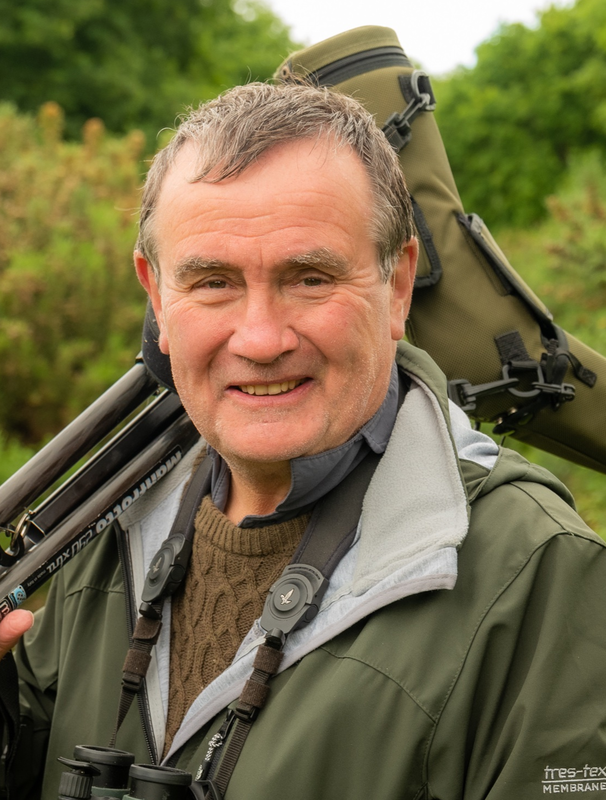
On my previous visit in March the 'swamp' (the literal translation of 'pantano') was, like most wetlands in Andalucia, very dry with most 'pools' were little more than mud-pans. As the photos below indicate, this time the situation was very different with scarcely any exposed mud and all the pools full to the brim. The other obvious difference was the sheer number of birds particularly Glossy Ibis. The latter were breeding in the swamp but with so much action with birds flying to and fro the exact number present was difficult to judge - I got to about 200 birds before realising an accurate count was impossible. Similarly, it was difficult to judge the number of Purple Heron and Little Bittern present as it was difficult to avoid double counting flying birds but I settled for a modest total of seven for the former and three for the latter making it one of the easiest sites for seeing these skulking species. Also present were 13 Spoonbill and a sprinkling of Little and Cattle Egrets and Night Herons. Ducks too were well represented with Mallard, a dozen Pochard, a couple of Red-crested Pochard and a few Shoveler. Waders included Black-winged Stilt, a pair of Little Ringed Plover, Pratincole, Common Sandpiper and Snipe. Amongst the noisy sixty odd Black-headed Gull were 18+ Whiskered Tern (both breeding here). In short, when wet It's an even better site for a quick detour from a journey along the AP4/E5 Seville-Cadiz motorway.

Despite being the better known site, I found Laguna la Mejorada much less productive for birds than the nearby Humedal El Pantano although it did have more Whiskered Terns (38). The nearby NIV and its junctions have changed since my last visit and the tracks around this site have been improved and upgraded. There are several routes to the Laguna de Mejorada. If arriving from the NIV you can turn north at the roundabout onto the service road and then first right (a) along a narrow track shrouded by tamarisks. If you miss this turning you can continue along the road and take the track (b) next to the canal. Alternatively, if coming from Los Palacios on the NIVa take the track opposite the Puegot dealership (c) which is c1km from the final roundabout in Los Palacios (or c1 km south of the junction with the NIV). If you want to avoid the drive through Los Palacios from the AP4/E5 then take the road (d) along the agricultural canal (see Google maps or my guide for details).
Most of the laguna is completely shrouded by dense undergrowth on two sides but views can be obtained from the south-west corner of the laguna (e). If looking for Olivaceous Warbler try walking along the track (f) linking the canal and checking the tamarisk as you go. Views can also be gained from the rough track (g) running along the western edge of the laguna.

As already noted the main purpose of this detour on the route home was to see Azure-winged Magpie (or 'Iberian Magpie') which I'd not seen for several years despite looking in Algaida pines many times. Hence, I'm very grateful to Gordon Shaw for bringing this site to my attention. Finding them proved even easier than I'd anticipated as I saw several birds as I drove up through the pines to Hotel Oromana(a). That afternoon I walked through the park to the Dragon Bridge (b) but only found Azure-winged Magpie in the open pinewoods near the hotel. Fortunately, they were very easy to find in that area and down to the children's playground below the hotel. Also present in these open pine woods were Golden Oriole and Hoopoe. That evening and again the next morning, I had a look at the riverside woodland (c). Here I found, amongst others, Olivaceous Warbler and Iberian Green Woodpecker. I studiously tried to ignore the parakeets squawking in the trees assuming that they were Monk Parakeets (ubiquitous in many parks in Spain) but when I bothered to look I found that they were actually Rose-ringed Parakeets.

 RSS Feed
RSS Feed
